CBSE Class 7 Maths Notes Chapter 10 Practical Geometry
Construction of Triangles
1. Properties of triangles
- The exterior angle of a triangle is equal in measure to the sum of interior opposite angles.
- The total measure of the three angles of a triangle is 180°.
- Sum of the lengths of any two sides of a triangle is greater than the length of the third side.
- In any right-angled triangle, the square of the length of the hypotenuse is equal to the sum of the squares of the lengths of the other two sides.
2. Essential measurements for the construction of a triangle
A triangle can be drawn if any one of the following sets of measurements is given:
- Three sides: SSS
- Two sides and the angle between them: SAS
- Two angles and the side between them: ASA
- The hypotenuse and a leg in the case of a right-angled triangle: RHS
Construction of a line parallels to a given line, through a point not on the line.
Steps of Construction
Step 1: Take a line ‘l’ and a point ‘A’ outside ‘l’

Step 2: Take any Point B on l and join B to A.
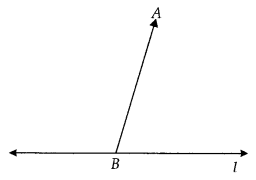
Step 3: With B as centre and a convenient radius, draw an arc cutting l at C and BA at D.
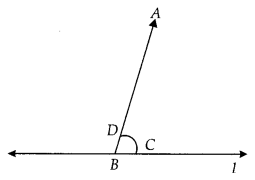
Step 4: Now with A as centre and the same radius as in Step 3 draw an arc EF cutting AB at G.

Step 5: Place the pointed tip of the compasses at C and adjust the opening so that the pencil tip at D.
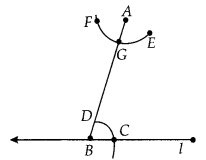
Step 6: With the same opening as in Step 5 and with G as centre, draw an arc cutting the arc EF at H.
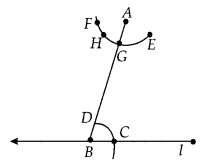
Step 7: Now, join AH to draw a line ‘m’.

Construction of a triangle when the lengths of its three sides are known (SSS Criterion).
Steps of Construction
Step 1: First, we draw a rough sketch with a given measure.
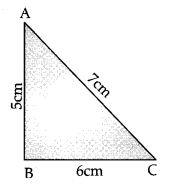
Step 2: Draw a line segment BC of length 6 cm.
![]()
Step 3: From B, point A is at a distance of 5 cm. So with B as centre, draw an arc of radius 5 cm.

Step 4: From C, point A is at a distance of 7 cm. So, with C as centre, draw an arc of radius 7 cm.
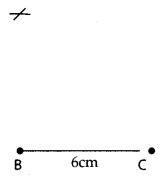
Step 5: A has to be on both the arcs drawn. So, it is the point of intersection of arc.
Mark the point of intersection of arcs as A. Join AB and AC. ΔABC is now ready.

Constructing a triangle when the lengths of two sides and the measure of the angle between them are known. (SAS Criterion)
Steps of Construction
Step 1: First we draw a rough sketch with given measures.
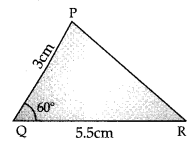
Step 2: Draw a line segment QR of length 5.5 cm.
![]()
Step 3: At Q, draw QX making 60° with QR.
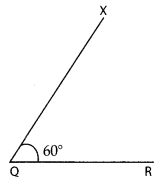
Step 4: With Q as centre, draw an arc of radius 3 cm. It cuts QX at the point E

Step 5: Join PR. ΔPQR is now obtained.
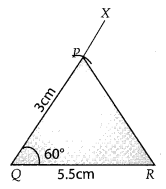
Constructing a triangle when the measures of two of its angles and the length of the side included between them is given (ASA Criterion)
Steps of Construction
Step 1: Before actual construction, we draw a rough sketch with measures marked on it.

Step 2: Draw XY of length 6 cm.
![]()
Step 3: At X, draw a ray XP making an angle of 30° with XY. By the given condition Z must be somewhere on the XP.
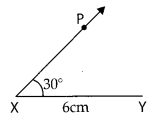
Step 4: At Y, draw a ray YQ making an angle of 100° with YX. By the given condition, Z must be on the ray YQ also.
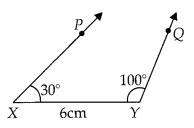
Step 5: Z has to lie on both the rays XP and YQ. So, the point of intersection of two rays is Z.

ΔXYZ is now completed.
Constructing a Right-Angled Triangle when the length of one leg and its hypotenuse are given (RHS Criterion).
Steps of Construction
Step 1: Draw a rough sketch and mask the measures. Remember to mark the right angle.

Step 2: Draw MN of length 3 cm.
![]()
Step 3: At M, draw MX ⊥ MN.

Step 4: With N as centre, draw an arc of radius 5 cm.
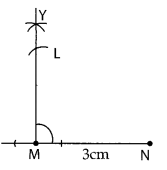
Step 5: L has to be on the perpendicular line MX as well as on the arc drawn with centre N. Therefore, L is the meeting point of these two ΔLMN is now obtained.
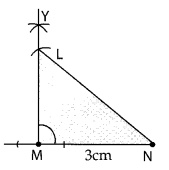
Class 7 Maths Notes
<!–
–>